#ætt
Text
Hello I am looking for someone willing to translate Norwegian to english for me. I am unable to pay anything but if anyone speaking both languages has free time I have many postcards I need translated for my ancestry work.
Norwegian:
Hei, jeg ser etter noen som er villig til å oversette norsk til engelsk for meg. Jeg kan ikke betale noe, men hvis noen som snakker begge språk har ledig tid, har jeg mange postkort jeg trenger å oversette for arbeidet mitt.
#translator#ancestry#norwegian#looking for translator#norge#norway#norsk#norskblr#ætt#translation#english#Engelsk#translate#oversette
6 notes
·
View notes
Text

RUNE LORE – HAGALAZ ᚺ
Hagalaz is the ninth rune of the elder futhark and the first rune of the second Ætt (Hagal’s Ætt ).
In divination Hagalaz implies that there will be a shift in your life, a liberation from the old. Not all destruction is negative, and sometimes things have to be torn down in order to allow for new growth. Hagalaz clears away stagnation, weakness, and disease. Once the storm has passed a clear path is created for strong new growth.
Practice with the rune Hagal
Beloved disciples, you must profoundly meditate on the unity of life, on the Great Alaya of the universe, on the invisible world, on the parallel universes of the superior dimensions of space.
Concentrate your thought on the Valkyries, Gods of fire, air, water, and earth.
Agni is the God of fire. Paralda is the God of air. Varuna is the God of water. Gob is the God of the element earth.
Through meditation you can enter into communication with the Gods of the elements.
You must trace the Rune Hagal on a blank paper, then after, concentrate your mind on any of the four principal Gods of the elements. Call upon them so they can help you when it is necessary. (Samael Aun Weor)
58 notes
·
View notes
Text






Fenrir
Other names: Fenrisúlfr, Hróðvitnir, Vánagandr
Parents: Loki , Angrboða
Siblings: Hel, Jörmungandr
Consort: Angrboða
Offspring: Hati Hróðvitnisson, Sköll
Mythology
*As a disclaimer with mythology. A lot have been lost to time. There are theories and attempts to reconstruct things although we may not truly know. A lot of lore has been Christianized like the Poetic Eddas.*
The Binding of Fenrir
The binding of Fenrir have many iterations and telling. The general story goes that the gods found Loki's children. They feared Fenrir because of his rapid growth. Some instances that Odin feared his fate and trying to delay it. The gods decided that they would bind Fenrir. As in Ragnarok Fenrir would kill Odin.
They threw Jörmungandr into the sea and Hel into Helheimr but they took Fenrir with them to keep an eye on him. Tyr was the only one who approached and fed him. As Fenrir grew the gods decided that he would not stay and tried to trick him into fetters. Fenrir broke every fetter until Skirnir went to the dwarves challenging them to make a chain that he could not break. The dwarves answered this challenge. They made a chain from the sound of a cat's footfall, the beard of a woman, the roots of a mountain, bear's sinews, fish's breath, and bird's spittle. They named this chain Gleipnir.
The gods challenged Fenrir to break Gleipnir but he knew this was a trick. He said that he would do so only if one of the gods would place his right hand in Fenrir's mouth as a pledge to free him if he failed to break the chain. (In Germanic culture, your right hand was used to swear an oath, and oaths were very serious. "oathbreakers" were sent to Náströnd as long with murderers and adulterers.)
Tyr was the one who stepped forward and placed his hand in Fenrir's mouth. But when Fenrir couldn't break free and the gods didn't keep their oath. He bit Tyr's hand off.
Járnviðr
A forest located east of Midgard, inhabited by trollwomen who bore jötnar and giant wolves.
Gylfaginning
Þá mælti Gangleri: "Skjótt ferr sólin ok nær svá sem hon sé hrædd, ok eigi myndi hon þá meir hvata göngunni, at hon hræddist bana sinn."
Þá svarar Hárr: "Eigi er þat undarligt, at hon fari ákafliga. Nær gengr sá, er hana sækir, ok engan útveg á hon nema renna undan."
Þá mælti Gangleri: "Hverr er sá, er henni gerir þann ómaka?"
Hárr segir: "Þat eru tveir úlfar, ok heitir sá, er eftir henni ferr, Skoll. Hann hræðist hon, ok hann mun taka hana. En sá heitir Hati Hróðvitnisson, er fyrir henni hleypr, ok vill hann taka tunglit, ok svá mun verða."
Þá mælti Gangleri: "Hverr er ætt úlfanna?"
Hárr segir: "Gýgr ein býr fyrir austan Miðgarð í þeim skógi, er Járnviðr heitir. Í þeim skógi byggja þær tröllkonur, er Járnviðjur heita. In gamla gýgr fæðir at sonum marga jötna ok alla í vargs líkjum, ok þaðan af eru komnir þessir úlfar. Ok svá er sagt, at af ættinni verðr sá einna máttkastr, er kallaðr er Mánagarmr. Hann fyllist með fjörvi allra þeira manna, er deyja, ok hann gleypir tungl, en stökkvir blóði himin ok loft öll. Þaðan týnir sól skini sínu, ok vindar eru þá ókyrrir ok gnýja heðan ok handan.
Then said Gangleri: "The sun fares swiftly, and almost as if she were afraid: she could not hasten her course any the more if she feared her destruction." Then Hárr made answer: "It is no marvel that she hastens furiously: close cometh he that seeks her, and she has no escape save to run away." Then said Gangleri: "Who is he that causes her this disquiet?" Hárr replied: "It is two wolves; and he that runs after her is called Skoll; she fears him, and he shall take her. But he that leaps before her is called Hati Hródvitnisson. He is eager to seize the moon; and so it must be." Then said Gangleri: "What is the race of the wolves?" Hárr answered: "A witch dwells to the east of Midgard, in the forest called Ironwood: in that wood dwell the troll-women, who are known as Ironwood-Women. The old witch bears many giants for sons, and all in the shape of wolves; and from this source are these wolves sprung. The saying runs thus: from this race shall come one that shall be mightiest of all, he that is named Moon-Hound; he shall be filled with the flesh of all those men that die, and he shall swallow the moon, and sprinkle with blood the heavens and all the air; thereof shall the sun lose her shining, and the winds in that day shall be unquiet and roar on every side
Völuspá
40. Austr sat in aldna í Járnviði
ok fæddi þar Fenris kindir;
verðr af þeim öllum einna nokkurr
tungls tjúgari í trölls hami.
In the east sat the old woman in Iron-wood and gave birth there to Fenrir's offspring; one of them in trollish shape shall be snatcher of the moon.
Thursatru and Rökkatru
Anticosmic Norse Paganism or Thursian sorcery venerates the Thursian giants. This is a Left Handed Path tradition. In the Thursian tradition Fenrir represents primal forces and chaos.
Definition of Anticosmic
Anti-Cosmic Satanism, also known as Chaos-Gnostic Satanism and Anti-Cosmic Gnosticism, is a belief system that believes that the Demiurge imprisoned humans with Cosmic Chains, holding us back from our true freedom in Chaos and Limitlessness. It believes that through the liberation of our mortal chains, we will once more return to Tohu/Ain - nothingness
The Aesir representing the Demiurge powers. Ragnarok freeing the chains and bringing everything back to the Ginnungagap.
The Thursar, the Old Norse primordial Giants, are seen as the more destructive forces raised against that cosmic order of the creation even into the given final culmination of Ragnarök or Ragnarökkr.
Abby Helasdottir coined the term Rökkatru. This is separate from the Thursian path.
Rökkatru's primary focus was the third pantheon of underworld Gods. These include Hela, Loki, Angrboda, Sigyn, Fenrir, Jormundgand, Narvi and Vali, Surt, Mordgud, and Mengloth, among others.
Working with Fenrir
*Please know basic protections and energy work before attempting any deity work.*
Offerings: Blood (when making oaths), Dragonsblood, Frankincense, Meat,
Rituals
⬩ Some practitioners can do a ritual to Fenrir to initiate under him when ready. This is not recommended for those not ready and or those who have any doubts about it. Breaking this oath as with any oaths for other deities will result in consequences.
⬩ A blót for Fenrir. Offer him the finest of meat.
⬩ Ritual for strength
⬩ Thursian rituals
Altar
Set up an altar/sacred space for performing rituals or giving offerings. Items may include
⬩Altar cloth
⬩Candles (color doesn't matter, black is fine)
⬩Cup or chalice
⬩Incense and incense burner
⬩Offering bowl
⬩Statues of Fenrir, wolf statue. Carvings of his name in runes. ᚠᛖᚾᚱᛁᚱ
For more information on basic deity work and altar setups check out the deity work post
Experience
In my personal experience in talking to people who worked with Fenrir. I've met a practioner who didn't think Loki was Fenrir's father. That Fenrir is not bound. He doesn't appear to be bound. He answers those who are strong and come in time of need. He is distant and quiet at first but will become more vocal over time.
I have also come across ideas of a priest and priestess of Fenrir. Priestess having deep connections with him. This tied into the concept that priestess had intimate and deep connections to gods and those of primal and primordial nature. Priest had deep connections to goddesses. This concept is in Greek mythology and heiros gamos.
Fenrir the one of primordial fire, chaos and the primal current. The one who is a shapeshifter. Father of wolves. Looks for those who are strong for he sees true strength. A test, a trial for those who are true. He is a serious deity. He sends a storm in his blessing.

For more content follow my main blog to see posts about all kinds of occult/pagan/witchcraft related stuff
If you have any other questions or wish to join a community feel free to join my 18+ occult server
Ask me anything on my blog
#occult#witchcraft#Witch#Norse#norse paganism#norse gods#fenrir#vanagandr#Wolf Father#deity#occultblr#Occult#occultism#witchblr#paganism#paganblr#deity work#Hróðvitnir#fenris#Fenrisúlfr#Thursatru#rökkatru#Thursian Sorcery
23 notes
·
View notes
Text
Sigillum by Roberto Ferri

RUNE LORE – HAGALAZ ᚺ
Hagalaz is the ninth rune of the elder futhark and the first rune of the second Ætt (Hagal’s Ætt ).
In divination Hagalaz implies that there will be a shift in your life, a liberation from the old. Not all destruction is negative, and sometimes things have to be torn down in order to allow for new growth. Hagalaz clears away stagnation, weakness, and disease. Once the storm has passed a clear path is created for strong new growth.
Practice with the rune Hagal
Beloved disciples, you must profoundly meditate on the unity of life, on the Great Alaya of the universe, on the invisible world, on the parallel universes of the superior dimensions of space.
Concentrate your thought on the Valkyries, Gods of fire, air, water, and earth.
Agni is the God of fire. Paralda is the God of air. Varuna is the God of water. Gob is the God of the element earth.
Through meditation you can enter into communication with the Gods of the elements.
You must trace the Rune Hagal on a blank paper, then after, concentrate your mind on any of the four principal Gods of the elements. Call upon them so they can help you when it is necessary. (Samael Aun Weor)
16 notes
·
View notes
Text
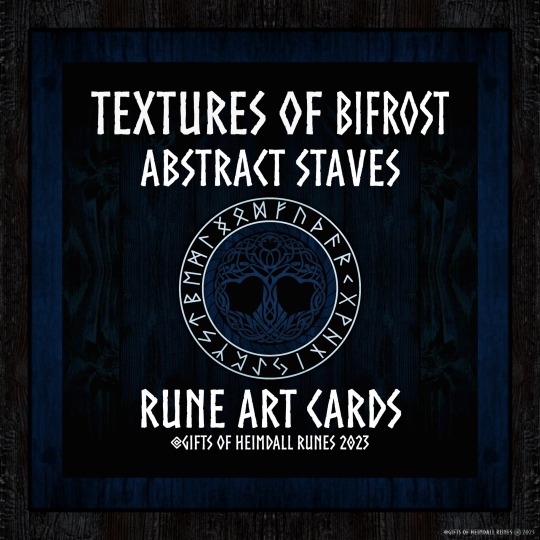


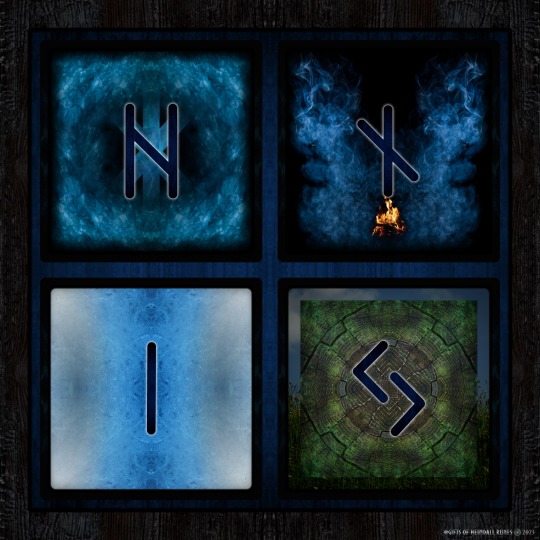

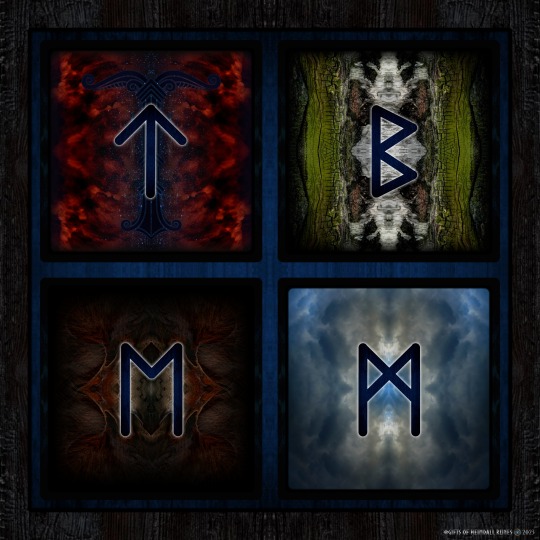

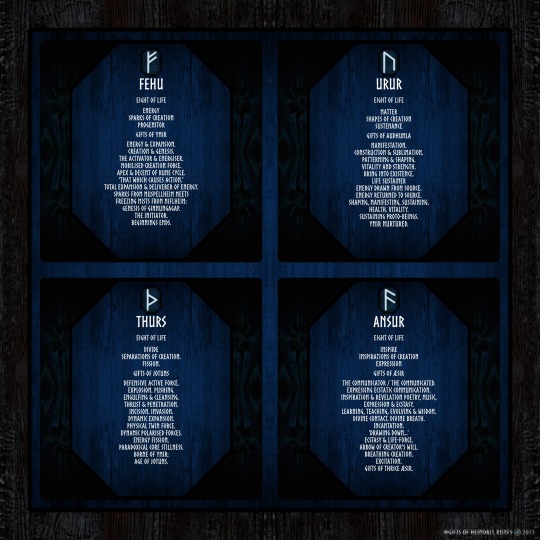
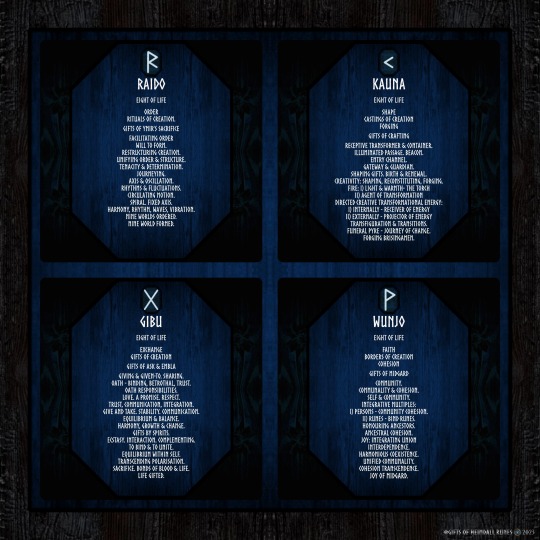
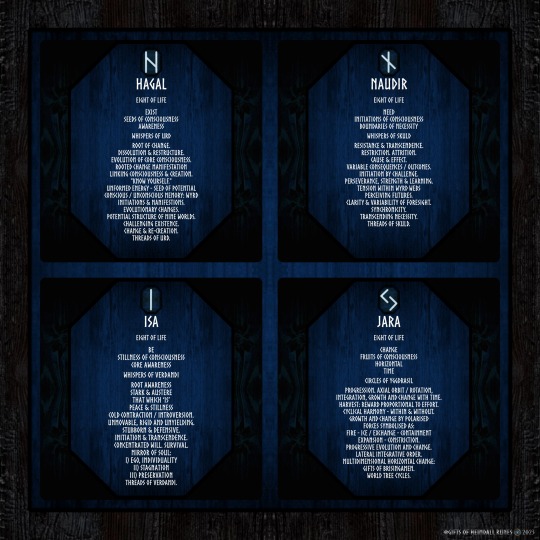

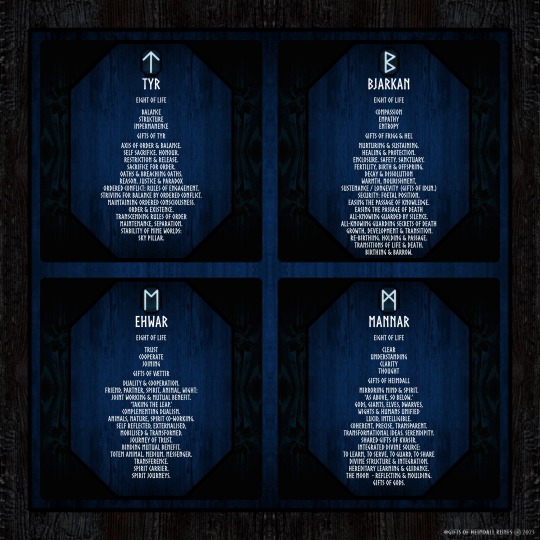
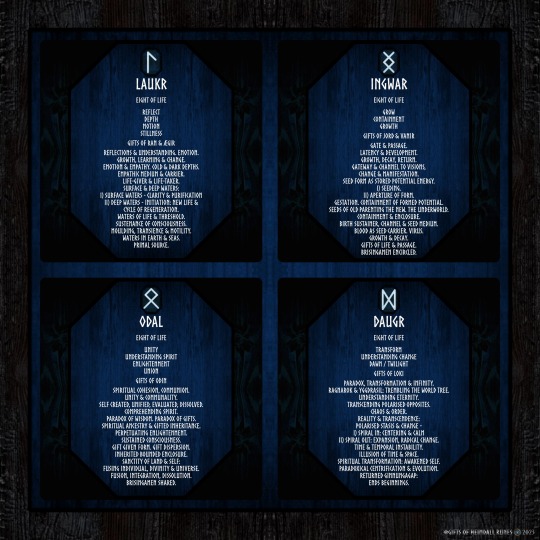
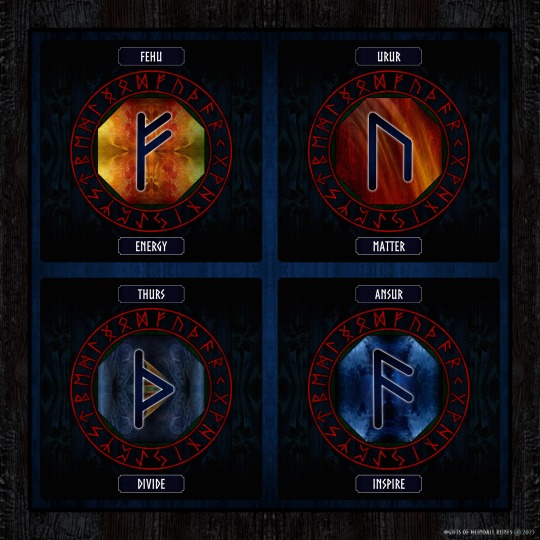
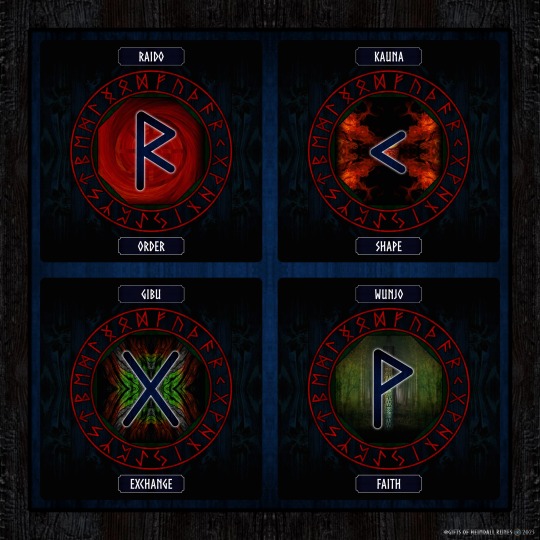

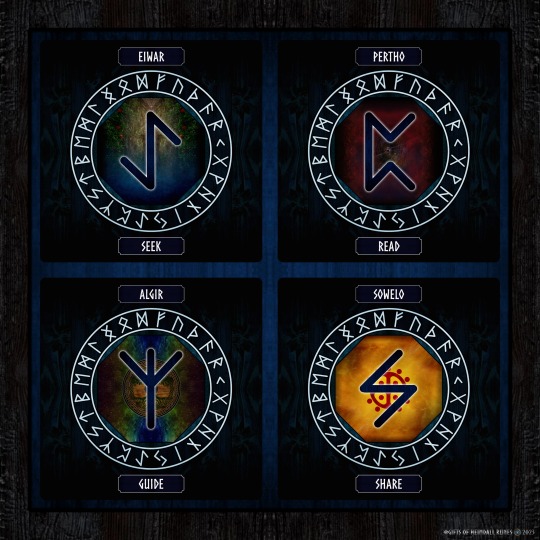


TEXTURES OF BIFRÖST - ABSTRACT STAVES
Elder Futhark Rune Art 2022
@Gifts of Heimdall Runes
●
"Textures of Bifröst - Abstract Staves" shared a rune art journey with twenty-four staves of the Elder Futhark. The project was an attempt to represent interactions with rune energy by creative expressions.
●
These designs were divided into three parts for this post:
○ Textures
○ Reflections
○ Rune Circles
●
The correspondences for runes were created as a gentle reminder of personal rune journeys over time. The text for each rune attempted to represent both a subjective journey within each individual rune and trans-personal initiations following the combined 24 staves of the Elder Futhark (beginning with Fehu & completing with Daugr.)
●
Rune names were taken from Wardruna albums 'gap var Ginnunga', 'yggdrasil' & 'Ragnarok'. The elective use of these rune names represented merely a personal tribute to Wardruna's wonderful music creations.
●
This project celebrated a continued journey with the runes and Spirit inspiration and to perhaps inspire others with their own rune travels. The project was created for fun and should only be considered as a product of a thoroughly eccentric middle-aged imagination that absolutely should know better but was now completely past caring!
●
'Textures of Bifröst' was created on & off within the first half of 2022, then shared October 2022 to March 2023 via social media platforms (Facebook, Instagram & partially Flickr.)
●
Reflections designs showed condensed ongoing personal rune meditations from 1997 to the present. Text showed some personal keywords and phrases formed by meditated interactions with each rune as well as engaging in study from various published authors. Content was also shared on 'Bifröst Shining' but again further developed for these designs.
●
The Brisingamen content with 'Reflections' came into consciousness with 'Bifröst Shining', which was shared 2021 & 2022. The myths and associations therein were still being worked upon. Future developments on this issue may, however, be forthcoming subject to Asgardian relations between Freya & Odhinn mitigated by intervention from Lokean mischief or Heimdallian diplomacy!
●
Collectively, each rune reflection card communicated an understanding of a journey of personal and trans-personal initiation throughout the three Ætts (eights) of the Elder Futhark that I have personally come to understand as:
●
○ First Eight: Journeys of Creation (as described by norse mythology).
○ Second Eight: Journeys Within: Norns and travelling Yggdrasil.
○ Third Eight: Journeys of Soul via the Norse Gods to Ragnarök.
●
Rune Circle cards showed condensed keywords from combined personal rune meditations. All rune correspondences in designs were subjective and should only be regarded as a load of nonsense that blossomed from an over-active aging hippy imagination.
●
Finally, the collection shown here was created for a private published copy by Make Playing Cards (MPC) that was adjusted to accommodate a 3.5 x 3.5 MPC template. The focus for 'Textures of Bifröst' from initial concept was on design, not publishing, which resulted in some slightly different pictures shared on Facebook & Instagram October 2022 to March 2023. Photos of these MPC printed rune art cards are also shown.
●
The project was dedicated to any steadfast followers that have kindly followed this journey with runes since 2019, and perhaps even before. Thank you, everyone!
●
'Textures of Bifröst - Abstract Staves' completed here.
The Gifts of Heimdall journey with runes continues.



Image Ref: World Tree Design
●
Gifts of Heimdall Runes (FACEBOOK)
Gifts of Heimdall Runes (INSTAGRAM)
#gifts of heimdall runes#gifts of heimdall#gifts of heimdall rune art#gifts of heimdall rune designs#HeimdallGiftsRunes#Rune#Runes#futhark#futhark runes#runes#norse runes#elder futhark#elder futhark runes#rune designs#rune art#elder futhark rune art#elder futhark rune designs#rune art cards#rune designs cards#personal rune art#personal rune designs#rune divination#rune magic#futhark rune art#futhark rune designs
33 notes
·
View notes
Text
Norns
The Norns are deities in Norse mythology responsible for shaping the course of human destinies.
In the Völuspá, the three primary Norns Urðr (Wyrd), Verðandi, and Skuld draw water from their sacred well to nourish the tree at the center of the cosmos and prevent it from rot. These three Norns are described as powerful maiden giantesses (Jotuns) whose arrival from Jötunheimr ended the golden age of the gods. The Norns are also described as maidens of Mögþrasir in the Vafþrúðnismál.

Beside the three Norns tending Yggdrasill, pre-Christian Scandinavians attested to Norns who visit a newborn child in order to determine the person's future. These Norns could be malevolent or benevolent: the former causing tragic events in the world while the latter were kind and protective.
There are a number of surviving Old Norse sources that relate to the norns. The most important sources are the Prose Edda and the Poetic Edda. The latter contains pagan poetry where the norns are frequently referred to, while the former contains, in addition to pagan poetry, retellings, descriptions and commentaries by the 12th and 13th century Icelandic chieftain and scholar Snorri Sturluson.
A skaldic reference to the norns appears in Hvini's poem in Ynglingatal 24 found in Ynglingasaga 47, where King Halfdan is put to rest by his men at Borró. This reference brings in the phrase "norna dómr" which means "judgment of the nornir". In most cases, when the norns pass judgment, it means death to those who have been judged - in this case, Halfdan. Along with being associated with being bringers of death, Bek-Pedersen suggests that this phrase brings in a quasi-legal aspect to the nature of the norns. This legal association is employed quite frequently within skaldic and eddic sources. This phrase can also be seen as a threat, as death is the final and inevitable decision that the norns can make with regard to human life. Ok til Þings Þriðja jǫfri Hvedðrungs mær ór heimi bauð pás Halfdan, sás Holtum bjó, norna dóms of notit hafði. Ok buðlung á Borrói sigrhafendr síðan fólu. And to a meeting Hveðrungr's maid called the third king from the world, at the time when Halfdan, he who lived at Holt, had embraced the judgment of the nornir; and at Borró the victorious men later did hide the king.
The Poetic Edda is valuable in representing older material in poetry from which Snorri tapped information in the Prose Edda. Like Gylfaginning, the Poetic Edda mentions the existence of many lesser norns beside the three main norns. Moreover, it also agrees with Gylfaginning by telling that they were of several races and that the dwarven norns were the daughters of Dvalin. It also suggests that the three main norns were giantesses (female Jotuns).
Fáfnismál contains a discussion between the hero Sigurd and the dragon Fafnir who is dying from a mortal wound from Sigurd. The hero asks Fafnir of many things, among them the nature of the norns. Fafnir explains that they are many and from several races: Sigurðr kvað: 12. "Segðu mér, Fáfnir, alls þik fróðan kveða ok vel margt vita, hverjar ro þær nornir, er nauðgönglar ro ok kjósa mæðr frá mögum." - Fáfnir kvað: 13. "Sundrbornar mjök segi ek nornir vera, eigu-t þær ætt saman; sumar eru áskunngar, sumar alfkunngar, sumar dætr Dvalins." Sigurth spake: 12. "Tell me then, Fafnir, for wise thou art famed, And much thou knowest now: Who are the Norns who are helpful in need, And the babe from the mother bring?" - Fafnir spake: 13. "Of many births the Norns must be, Nor one in race they were; Some to gods, others to elves are kin, And Dvalin's daughters some."
It appears from Völuspá and Vafþrúðnismál that the three main norns were not originally goddesses but giants (Jotuns), and that their arrival ended the early days of bliss for the gods, but that they come for the good of humankind.
Völuspá relates that three giants of huge might are reported to have arrived to the gods from Jotunheim: 8. Tefldu í túni, teitir váru, var þeim vettergis vant ór gulli, uns þrjár kvámu þursa meyjar ámáttkar mjök ór Jötunheimum. 8. In their dwellings at peace they played at tables, Of gold no lack did the gods then know,-- Till thither came up giant-maids three, Huge of might, out of Jotunheim.
Vafþrúðnismál probably refers to the norns when it talks of maiden giants who arrive to protect the people of earth as protective spirits (hamingjas): 49. "Þríar þjóðár falla þorp yfir meyja Mögþrasis; hamingjur einar þær er í heimi eru, þó þær með jötnum alask." 49. O’er people’s dwellings three descend of Mögthrasir’s maidens, the sole Hamingiur who are in the world, although with Jötuns nurtured.
The Völuspá contains the names of the three main Norns referring to them as maidens like Vafþrúðnismál probably does: 20. Þaðan koma meyjar margs vitandi þrjár ór þeim sæ, er und þolli stendr; Urð hétu eina, aðra Verðandi, - skáru á skíði, - Skuld ina þriðju; þær lög lögðu, þær líf kuru alda börnum, örlög seggja. 20. Thence come the maidens mighty in wisdom, Three from the dwelling down 'neath the tree; Urth is one named, Verthandi the next,-- On the wood they scored,-- and Skuld the third. Laws they made there, and life allotted To the sons of men, and set their fates.
The norns visited each newly born child to allot his or her future, and in Helgakviða Hundingsbana I, the hero Helgi Hundingsbane has just been born and norns arrive at the homestead: 2. Nótt varð í bæ, nornir kómu, þær er öðlingi aldr of skópu; þann báðu fylki frægstan verða ok buðlunga beztan þykkja. - 3. Sneru þær af afli örlögþáttu, þá er borgir braut í Bráluni; þær of greiddu gullin símu ok und mánasal miðjan festu. - 4. Þær austr ok vestr enda fálu, þar átti lofðungr land á milli; brá nift Nera á norðrvega einni festi, ey bað hon halda. 2. 'Twas night in the dwelling, and Norns there came, Who shaped the life of the lofty one; They bade him most famed of fighters all And best of princes ever to be. - 3. Mightily wove they the web of fate, While Bralund's towns were trembling all; And there the golden threads they wove, And in the moon's hall fast they made them. - 4. East and west the ends they hid, In the middle the hero should have his land; And Neri's kinswoman northward cast A chain, and bade it firm ever to be.
In Helgakviða Hundingsbana II, Helgi Hundingsbane blames the norns for the fact that he had to kill Sigrún's father Högni and brother Bragi in order to wed her: 26 "Er-at þér at öllu, alvitr, gefit, - þó kveð ek nökkvi nornir valda -: fellu í morgun at Frekasteini Bragi ok Högni, varð ek bani þeira.
"Maid, not fair is all thy fortune, The Norris I blame that this should be; This morn there fell at Frekastein Bragi and Hogni beneath my hand.
Like Snorri Sturluson stated in Gylfaginning, people's fate depended on the benevolence or the malevolence of particular norns. In Reginsmál, the water dwelling dwarf Andvari blames his plight on an evil norn, presumably one of the daughters of Dvalin: 2. "Andvari ek heiti, Óinn hét minn faðir, margan hef ek fors of farit; aumlig norn skóp oss í árdaga, at ek skylda í vatni vaða." 2. "Andvari am I, and Oin my father, In many a fall have I fared; An evil Norn in olden days Doomed me In waters to dwell."
Sigurðarkviða hin skamma
Another instance of Norns being blamed for an undesirable situation appears in Sigurðarkviða hin skamma, where the valkyrie Brynhild blames malevolent norns for her long yearning for the embrace of Sigurd: 7. Orð mæltak nú, iðrumk eftir þess: kván er hans Guðrún, en ek Gunnars; ljótar nornir skópu oss langa þrá." 7. "The word I have spoken; soon shall I rue it, His wife is Guthrun, and Gunnar's am I; Ill Norns set for me long desire."
Brynhild's solution was to have Gunnarr and his brothers, the lords of the Burgundians, kill Sigurd and afterwards to commit suicide in order to join Sigurd in the afterlife. Her brother Atli (Attila the Hun) avenged her death by killing the lords of the Burgundians, but since he was married to their sister Guðrún, Atli would soon be killed by her. In Guðrúnarkviða II, the Norns actively enter the series of events by informing Atli in a dream that his wife would kill him. The description of the dream begins with this stanza: "Svá mik nýliga nornir vekja," - vílsinnis spá vildi, at ek réða, - "hugða ek þik, Guðrún Gjúka dóttir, læblöndnum hjör leggja mik í gögnum." 39. "Now from sleep the Norns have waked me With visions of terror,-- To thee will I tell them; Methought thou, Guthrun, Gjuki's daughter, With poisoned blade didst pierce my body."
After having killed both her husband Atli and their sons, Guðrún blames the Norns for her misfortunes, as in Guðrúnarhvöt, where Guðrún talks of trying to escaping the wrath of the norns by trying to kill herself: 13. Gekk ek til strandar, gröm vark nornum, vilda ek hrinda stríð grið þeira; hófu mik, né drekkðu, hávar bárur, því ek land of sték, at lifa skyldak. 13. "To the sea I went, my heart full sore For the Norns, whose wrath I would now escape; But the lofty billows bore me undrowned, Till to land I came, so I longer must live.
Guðrúnarhvöt deals with how Guðrún incited her sons to avenge the cruel death of their sister Svanhild. In Hamðismál, her sons' expedition to the Gothic king Ermanaric to exact vengeance is fateful. Knowing that he is about to die at the hands of the Goths, her son Sörli talks of the cruelty of the norns: 29. "Ekki hygg ek okkr vera ulfa dæmi, at vit mynim sjalfir of sakask sem grey norna, þá er gráðug eru í auðn of alin. - 30. Vel höfum vit vegit, stöndum á val Gotna, ofan eggmóðum, sem ernir á kvisti; góðs höfum tírar fengit, þótt skylim nú eða í gær deyja; kveld lifir maðr ekki eftir kvið norna." - 31. Þar fell Sörli at salar gafli, enn Hamðir hné at húsbaki. 29. "In fashion of wolves it befits us not Amongst ourselves to strive, Like the hounds of the Norns, that nourished were In greed mid wastes so grim. - 30. "We have greatly fought, o'er the Goths do we stand By our blades laid low, like eagles on branches; Great our fame though we die today or tomorrow; None outlives the night when the Norris have spoken." - 31. Then Sorli beside the gable sank, And Hamther fell at the back of the house.
Since the norns were beings of ultimate power who were working in the dark, it should be no surprise that they could be referred to in charms, as they are by Sigrdrífa in Sigrdrífumál: 17. Á gleri ok á gulli ok á gumna heillum, í víni ok í virtri ok vilisessi, á Gugnis oddi ok á Grana brjósti, á nornar nagli ok á nefi uglu. 17. On glass and on gold, and on goodly charms, In wine and in beer, and on well-loved seats, On Gungnir's point, and on Grani's breast, On the nails of Norns, and the night-owl's beak.
In the part of Snorri Sturluson's Prose Edda which is called Gylfaginning, Gylfi, the king of Sweden, has arrived at Valhalla calling himself Gangleri. There, he receives an education in Norse mythology from what is Odin in the shape of three men. They explain to Gylfi that there are three main norns, but also many others of various races, æsir, elves and dwarves: A hall stands there, fair, under the ash by the well, and out of that hall come three maids, who are called thus: Urdr, Verdandi, Skuld; these maids determine the period of men's lives: we call them Norns; but there are many norns: those who come to each child that is born, to appoint his life; these are of the race of the gods, but the second are of the Elf-people, and the third are of the kindred of the dwarves, as it is said here: Most sundered in birth I say the Norns are; They claim no common kin: Some are of Æsir-kin, some are of Elf-kind, Some are Dvalinn's daughters. Then said Gangleri: "If the Norns determine the weirds of men, then they apportion exceeding unevenly, seeing that some have a pleasant and luxurious life, but others have little worldly goods or fame; some have long life, others short." Hárr said: "Good norns and of honorable race appoint good life; but those men that suffer evil fortunes are governed by evil norns."
The three main norns take water out of the well of Urd and water Yggdrasil: It is further said that these Norns who dwell by the Well of Urdr take water of the well every day, and with it that clay which lies about the well, and sprinkle it over the Ash, to the end that its limbs shall not wither nor rot; for that water is so holy that all things which come there into the well become as white as the film which lies within the egg-shell,--as is here said: I know an Ash standing called Yggdrasill, A high tree sprinkled with snow-white clay; Thence come the dews in the dale that fall-- It stands ever green above Urdr's Well. That dew which falls from it onto the earth is called by men honey-dew, and thereon are bees nourished. Two fowls are fed in Urdr's Well: they are called Swans, and from those fowls has come the race of birds which is so called."
Snorri furthermore informs the reader that the youngest norn, Skuld, is in effect also a valkyrie, taking part in the selection of warriors from the slain: These are called Valkyrs: them Odin sends to every battle; they determine men's feyness and award victory. Gudr and Róta and the youngest Norn, she who is called Skuld, ride ever to take the slain and decide fights.
Some of the legendary sagas also contain references to the norns. The Hervarar saga contains a poem named Hlöðskviða, where the Gothic king Angantýr defeats a Hunnish invasion led by his Hunnish half-brother Hlöðr. Knowing that his sister, the shieldmaiden Hervör, is one of the casualties, Angantýr looks at his dead brother and laments the cruelty of the norns: 32. Bölvat er okkr, bróðir, bani em ek þinn orðinn; þat mun æ uppi; illr er dómr norna." "We are cursed, kinsman, your killer am I! It will never be forgotten; the Norns' doom is evil."
In younger legendary sagas, such as Norna-Gests þáttr and Hrólfs saga kraka, the norns appear to have been synonymous with völvas (witches, female shamans). In Norna-Gests þáttr, where they arrive at the birth of the hero to shape his destiny, the norns are not described as weaving the web of fate, instead Norna appears to be interchangeable and possibly a synonym of vala (völva).
One of the last legendary sagas to be written down, the Hrólfs saga kraka talks of the norns simply as evil witches. When the evil half-elven princess Skuld assembles her army to attack Hrólfr Kraki, it contains in addition to undead warriors, elves and norns.
This romantic representation of the norns depicts one of them (Verdandi according to the runes below) with wings, contrary to folklore.
The belief in the norns as bringers of both gain and loss would last beyond Christianization, as testifies the runic inscription N 351 M from the Borgund stave church: Þórir carved these runes on the eve of Olaus-mass, when he travelled past here. The norns did both good and evil, great toil ... they created for me.
Three women carved on the right panel of Franks Casket, an Anglo-Saxon whalebone chest from the eighth century, have been identified by some scholars as being three norns.

Pic by burnggirl on deviantart
10 notes
·
View notes
Text


The original Ættir sword is an Ardra family heirloom. In paganism, its root word "ætt" is translated to "clan, family, or a group of things with close relations". Additionally, in Old Norse, "ætt" has a similar translation of "dynasty" or "lineage". The Ættir that Val wields present-day is of the original's design, however repurposed and strengthened for modern combat. Val utilizes the Ættir for close quarters encounters, while relying on mid-range firearms such as .44 magnum pistols and the occasional assault rifle or shotgun for what she calls, "extra fun". It's not unusual to see Val enter a combat zone with Ættir sheathed on her back. Val has, on multiple occasions, maneuvered with an impaled body on Ættir's blade as improvised cover.
#tag. headcanon.#val using a body impaled on her sword as cover while balancing her shooting arm on the poor guy's shoulder. kinda hot if you ask me#it does require val to be ambidextrous to a degree but she prefers her left hand.
9 notes
·
View notes
Text
I’d been bashing my head in trying to come up with a Draconic script—wanted to do something with triangles but just wasn’t feeling it—but then it came to me that dragons in my setting are the most arithmetically inclined species in existence (“for the hoard!”). So their letters? They ain’t letters: they’re an application of their numeral system.
Basically, they have 27 sounds, and 9 base digits (they have 3 fingers on each wing but count on the 10 toes of their forefeet, so they use decimal). They then arrange the sounds in a mnemonic poem, like the Iroha order of kana or one theory for why the Phoenician alphabet (ancestor of every living script except Chinese and its derivatives) has a seemingly random arrangement. Each letter of their alphabet is just a numeral with an element added to show which third of the alphabet it’s in. Which is how Norse cypher runes worked: the strokes on one side of the staff showed which of the three “clans” (ættir) of runes was meant, and the strokes on the other side show its order within its ætt.
(Why yes, this is just me coming up with a worldbuilding figleaf for only wanting to make ten base symbols. Astute of you to notice.)
Incidentally their numerals proper also borrow an element from the Cistercian ones: their actual base is thousands, though with a decimal subbase. They arrange the base numeral forms on the sides of a triangle, and so effectively write three-digit numbers as single characters.
0 notes
Text

✨Blessings to our heroes! This post I discuss how to send prayers (help) to those souls. Also both the Numerological & Pagan origin of 11/11! RUNES: I know quite a bit, check this out!
🔭🌠💜👽✨🌠💜👽✨
Now is 1st fortnight of the warrior tier(ætt) of Runes. 1=visual expression of Isa (ice). This is no different than what governs 11 being a master #. Meaning is in the metaphor: warriors(veterans) are formed of Ice, with minimal blessings of source's light... Such a path transforms a man into a source of value. Like the light itself. The value of stoicism... Let us learn, be useful to this country & our families!
🔭🌠💜👽✨🌠💜👽✨
I HANDMAKE primarily Talismans! I also make metaphysical clothing, paintings/sculptures for you or your loved ones!🌷All of my creations are made of 100s of ancient, powerful symbols! I use only the symbols I've seen to repeatedly work wonders!
🌷🔥🌟💥⚡☀️✨
I have been trying to rebuild all my jewelry & art that was stolen when I was assaulted & robbed (10 times past few years) I am looking for a quality SPIRITUAL STORE or ART GALLERY to TRULY help with sales/marketing their work & mine! I am a rare, tireless entertainer, salesperson and psychic. I have huge internet reach and can work day and night continuously! I don't even need to eat. I have got by on hard work & skill alone, not cheating & it shows! If you would like to make a connection happen contact me. If it works out I will pay you!
🌟 A very modest GoFundMe here! Please spread the word! https://gofund.me/82ac1c5b Thank you!🌟💜🗽💜🎿💜❄️💜🦌
.
.
.
.
.
#strugglingartist #spiritualjewelry #healingart #spiritualart #magicalart #homelessartist
#1111 Spiritualhealing crystalhealing eed #Metaphysics #veterans
#heroes
#mystical #magical #Magick
#fallenheroes
#Newageart
#fantasyart #einherjar
#vetsday #ascension #consciousness #psychicart #metaphysicalart #spiritualartist
#magicart #veteransday
#vikingsquote #warriorsquote
#spiritualpoems #spiritualquotes #Newagequotes http://dlvr.it/Syj4SK
0 notes
Text
Heljarkviða II: Helgrindr brotnar
Óðins sonr andvana at Haðars hǫndum ok Lopts vilja, eftir sitja sigtíva synir ok heimakyn veglaus í svalheimi ofan. Bragar kvónar hvarma hrynregns herjar á mellu dólgs móðr æ síðan ok fjǫrtál magnask krafti með sorta gullslegins alar Forseta. Stála æski-Baldr kom heim. Nú hrings setr liggr frammi fyr inni sem blá half en half með hǫrundar lit sitr at Eljúðnum, skjálfti er markaðr þessu kalda votlendi aldrstila. Þá er Sleipnir snart Helgrindr, þá er hjaraflóð gjǫll rísa ok hylja eyðilendr með dǫkkrauðu eitri, þá er Nástǫnd ber ofgótt fǫlra gunnhvata náa. Þpa er Helgrindr brotnar niðr! Herþruma ok dolgeisa í dǫkkvandi regns hátunni, flækt i Ýmis skýja slóð, afhjúpa grimm ǫrlǫg guma!
Fyllisk fjǫrvi
feigra manna,
rýðr ragna sjǫt
rauðum dreyra;
svǫrt verða sólskin
um sumur eftir,
veðr ǫll válynd.
(Vǫluspá 41)
Gól of ásum
Gullinkambi,
sá vekr hǫlða
at Herjafǫðrs;
en annarr gelr
fyr jǫrð neðan
sótrauðr hani
at sǫlum Heljar.
(Vǫluspá 43)
Hvellt hljóð klýfr þá níu heima sem þyngsk bǫnd bresta sundr ok kveldríðu stóð Varðrúnar viggja renna undan viðþolslaust. Garmr er sá nefndr, sem frá vatnsmynni Gnipahellis tveggja bági rennr til at færa at fjǫrslit þess eineygða áss gunnhvata óðann ok hans herlið frá Valhǫllu. Nú skelfr Jarðar hals ok linns blóðar miklask upp eftit, linna ei Ratatǫski at færa hergamms orð at Níðhǫggi. Jólna sumbl renna saman ok dolga fangs barr bersk hvor við annan. Nú hefsk Herjans tuggu leikr. Nú rís vagna græðir. Nú blæs ragna reinvári í sitt Gjallarhorn ok skilr við Himinbjǫrg hinsta sinni.
Hrymr ekr austan,
hefisk lind fyrir,
snýsk Jǫrmungandr
í jǫtunmóði;
ormr knýr unnir,
en ari hlakkar,
slítr nái niðfǫlr,
Naglfar losnar.
(Vǫluspá 50)
En Fenrisúlfr ferr með gapandi munn, ok er inn neðri kjǫftr við jǫrðu, en in efri við himin. Eldar brenna ór augum hans ok nǫsum. Miðgarðsormr blæss svá eitrinu, at hann dreifir loft ǫll ok lǫg, ok er hann á aðra hlið úlfinum. (Gylfaginning 51)
Frá austri ok frá suðri, frá bǫlrǫnn ok frá illskáu hermagni Niflheljar undirheima, Lokabǫrn ok Surts ætt, ǫll magna grimmiligt élregn umlykjandi glatan.
Troða halir helveg,
en himinn klofnar.
(Vǫluspá 52)
Hropts hjalmeldar gildar ok kvikyndi, Vana guðir ok Ymis niðjar, goð ok frumberi uppskorna visku, Einherjar at Valhǫll ok blóðorra bǫrr frá svǫrtum strǫndum, allir valbráð þeirrar miklu orrustu við Ragnarǫk. Ok þá skar Surtr Bifrǫst Surtarloga, dǫkkva slegin brátungl Marnars fǫðr, skipar at hrótgarmi ok mélar þau bensævar rǫnn sem dreyfask um jǫtna dolgs móðr.
Sól tér sortna,
sígr fold í mar,
hverfa af himni
heiðar stjǫrnur;
geisar eimi
ok aldrnari,
leikr hár hiti
við himin sjalfan.
(Vǫluspá 57)
En nú nýr elds heimr rís. Æsir snúa aftr ok Yggjar brúðr skal græn á ný verða. En þá er Níðhǫggr snýr aftr, sá allra landa endiseiðr, flýgr hann yfir vǫllu ok ber rauðs eggjar á vindǫr sinni. Valbráð ulfs tugga mun skjǫgra helvegar manns mjǫtvið á ný. Niðurum ok þvert á lífs heima, niðurum í hrollkalda dauða heima.
[ENGLISH - Helgrindr bursts asunder]
Baldr died by Hǫðr's hands and Loki's will, leaving gods and humans lost in worlds above. Rivers of tears bursting into lands ever since and mischief gains power by darkening the golden-shielded halls of Forseti. Baldr came home. Now he lies before the half-rotten queen of the snake hall, shivering engraved in this cold and wet lands of death. This is when Sleipnir touches Helgrindr. This is when sword-filled Gjǫll rises and covers the wastelands with dark-red poison. This is when Nástrǫnd is most filled with bleak-faced corpses of shielded sword-arms. This is when Helgrindr bursts asunder! Thunder and lightning in dark clouds, entangled in Ýmir's brain, unveil the bleak future of mankind!
The corpses
of doomed men fall,
the gods' dwellings are reddened
with crimson blood;
sunshine becomes black
the next summer
all weather is vicious.
(Vǫluspá 41)
Golden-comb crowed
for the Æsir,
he wakens the warriors
at the Father of Hosts';
and another crows
down below the earth,
a sooty-red cock
In the halls of Hel.
(Vǫluspá 43)
A roaring sound shatters the nine worlds as the heaviest wrist bursts asunder and the wolf of wolves starts to run without resistance. Garmr he is called, from the water's mouth at Gnipahellr he runs to bring death to the one-eyed god of war-madness and his army from Valhǫll. Now Yggdrasill trembles and snakes gorge their way upwards, giving Ratatǫskr no chance to bring the eagle's words down to Niðhǫggr. Words collide and brothers slay each other. Now axes start to play their game. Now waters starts to rise. Now Heimdallr blows Gjallahorn and leaves Himinbjǫrg forever.
Hrymr drives from the east,
he has his shield before him,
Jǫrmungandr writhes
in giant rage;
the serpent churns the waves,
the eagle shrieks in anticipation,
pale-beaked he tears the corpse,
Naglfar breaks loose.
(Vǫluspá 50)
Fenris shall advance with gaping mouth, and his lower jaw shall be against the earth, but the upper against heaven. Fires blaze from his eyes and nostrils. Jǫrmungandr shall blow venom so that he shall sprinkle all the air and water, and shall be on one side of the Wolf. (Gylfaginning 51)
From the east and from the south, from Hel and from Niflhel fierceful armies of the underworlds, Children of Loki and Muspell's people, all raise the furious storm of impending doom.
Men tread the road to Hel,
and the sky spits apart.
(Vǫluspá 52)
Æsir and beasts, Vanir and giants, gods and primordial harvester of wisdom, worriors at Valhǫll and murderers from the black sands, all die in the furious battle of Ragnarǫk. And then Surtr cuts Bifrǫst with Surtalogi, darkens the thrown eyes of Þjazi, commands the hasty one and smashes all remaining bodies to the scourged ground below.
The sun turns black,
earth sinks into the sea,
the bright stars vanish
from the sky;
steam rises up
in the conflagration,
a high flame plays
against heaven itself.
(Vǫluspá 57)
But a new sun rises. Æsir return and the earth becomes all green again. But when Niðhǫggr returns, the flying serpent, he flies over the plain and carries corpses on his wings. Slain people will wander the path to Hel again. Downwards and reversed to worlds alive, downwards to gloomy worlds of death.
#Árstíðir lífsins#Arstidir Lifsins#International#Pagan Black Metal#Black Metal#Iceland#Germany#Bandcamp
0 notes
Text
09-09-2023 biltúrur norðueftir. Tíðlja upp - bara til stongdar morgunmatar dyr, tú hon sum skuldi fyrireika hevi forsovið seg. Har stóðu 20 svangir penstionistar - og vit - og bíðau. So okkara fráferð var seinkað, so vit náddu ikki Gøttingen sum ætlað, men eru logeraðar inn á Serways Hotel ein tíma sunnanfyri okkara upprunaliga mál .

Og fyri at gera alt betur, so fingu vit eina non-gourmet høsnarætt, men við Rioja víni. Tíverri funnu vit ikki upptrekkjarin við tí úrsliti, at vínið sprændi í allar ættir og líka upp undir loft tá proppurin bleiv trýstur niður. Vit vóna tað besta og at rokningin ikki verður ov stór og at dagurin í morgin eydnast betur. So náa vit Danmark seinnapartin!
Vit koyra og alt gongur væl - men so rendu vit okkum í fleiri proppar í ferðsluni vegna ferðslu vanlukkur og arbeiðir á vegnum!

Men fram komu vit til Fredericia har Gudmund var komin at avheinta Jüttu og vit koyrdu í hvør sína ætt.
So var slutt fyri hesuferð.
1 note
·
View note
Text
The Aetts
The 24 runes of the Eldar Futhark are usually separated out into three separate groups, known as Aetts (Ætt singular / Ættir plural). The division can be viewed in a number of different ways, such as a degree system of initiation or the divisions of tribal society (Farmer, Warrior, Priest/Chief). Each aett contains runes which represent similar functions and overlapping meanings but which are…
View On WordPress
0 notes
Photo

Just this one more smocktastic snap for now... #smock #britishmillerain #ætt
1 note
·
View note
Photo


Hap Birf to Arvokas Valo!! born on Melona 19th, 25 BBY!
the oldest Valo sibling, but only by sheer technicality b/c he’s not actually of Valo blood. the son of Darthustra and Aberrant, but he was unaware of his mother’s name, as she abandoned him almost as soon as he was born and after she killed his father. however, he was saved by another member of his father’s Nightbrother tribe, a man by the name of Pious, who raised him as his own and eventually as an older brother to his other/younger adoptive son.
but, as it turns out, the other child Pious saved and aimed to raise was Jumalan’s only son Taivas. And after Darthustra’s death, Jumalan was able to make his way to the Nightbrothers’ village seeking refuge, where he was reunited w/ his son and given the means to return home. Arvo, finding this out, decided he didn’t want to part w/ his baby brother nor did he want anything to do w/ Dathomirian cultural as it currently stood, so he asked Jumalan if he could go to Bespin w/ him. Jumalan readily agreed, and upon arrival (and after explaining the situation to everyone else), Aamun gave him the new name Arvokas (which has the complete opposite meaning as his deadname) and he was considered part of the family, tho not necessarily officially adopted.
it took many years before it was finally revealed that he did in fact share blood w/ both Taivas and Tähtien; in fact, it was Tähtien’s arrival that finally brought everything to light (no pun intended). years prior, when Jumalan had nonchalantly asked him for more details on his background/parentage, he’d put two and two together about Arvo’s mother. but due to the sheer amount of trauma he was still dealing w/ over that whole situation, he kept the realization to himself. fast forward to when Tähtien returned home, took one look at Arvo, saw the resemblance between him and Taivas, and finally Jumalan figured he couldn’t hide the truth anymore.
one other thing about him is that during the years prior to Tähtien’s return, he spent a lot of time w/ the new head of Málmur Ætt after catching their eye during a festival/ceremony one night. Myrkur, being one of few Force-sensitive members of Jah Karai, saw that sensitivity in Arvo as well. and given that they were still new to not only being head of their family but technically head of the whole tribe as well, part of them shirking their responsibilities was spending time training Arvo in the ways of the Force. that, and they could tell he was having trouble adjusting but didn’t quite feel comfortable bring all that up w/ his new family, so Myrkur was a welcomed mentor at that point in time.
~one year later...
need to readjust some stuff here to align his story w/ the most recent update to Taivas’ story; since i decided it made no sense for Jumalan and Darthustra to have another kid together, nor did it also not make sense for him to just leave a baby out in the wild w/ nothing but a prayer that someone would find said kid, i’ve switched it to these two half-brothers being raised together since birth. Arvo is still the other brother by five years, and they’ve known from the start they share a mother instead of it being a mystery. it was also a joint decision for them wanting to leave Dathomir together when Jumalan showed up looking for safe passage back to Bespin; they both just simply wanted out of that culture, tho still grateful to Pious for being their foster father.
so obviously this connection is why he has the closest relationship to Taivas out of all his siblings; as i’ve mentioned, it’s difficult for him to open up to others. i think early on he might’ve been worried that he was gonna lose said connection some time after Minun and Auri were born (which could’ve been another reason why he felt Myrkur was the only person he could talk to); if anything, the culture shock likely affected him more and longer than he initially realized. it was an extensive adjustment period, but he eventually figured out that he was by no means losing a brother. also once the Force sensitivity started manifesting in all the Valo siblings, his training w/ Myrkur was a way for him to settle in a bit better.
#including a bit of art b/c it's just so hard to get these dollmakers to do what i want#due to being dropped on his head after birth (in his mother's attempt to kill him) the horns on that side of his head never grew in#as for the hair style showing that off tho that's more of a personal choice#i'm still trying to figure tho if/how that may manifest in other ways (like mental stuff; be it trauma related or something else)#otherwise he's just generally the quietest among the valo siblings; he can be friendly and caring but it's kinda hard to get him to open up#sw oc tag#star wars#random bullshit#drawins#arvokas valo#valo ætt
4 notes
·
View notes
Photo








Boldness - Heldenmoed - Tivaż.
https://nl.pinterest.com/pin/501729214727924900/.
http://moje-kniha-stinu.blog.cz/1412/runy-cesta-k-runam-cesta-za-starymi-bohy-a-pohanskymi-tradicemi-20 .
Birch - Berk - Barko. "Bright White."
https://nl.pinterest.com/pin/501729214727924893/.
http://moje-kniha-stinu.blog.cz/1412/runy-cesta-k-runam-cesta-za-starymi-bohy-a-pohanskymi-tradicemi-21.
Horse - Paard - Äjvaż
https://nl.pinterest.com/pin/501729214727924874/.
http://moje-kniha-stinu.blog.cz/1412/runy-cesta-k-runam-cesta-za-starymi-bohy-a-pohanskymi-tradicemi-22.
Man - Mens(heid) - Mądry/Manż. "Thinking."
https://nl.pinterest.com/pin/501729214727924860/.
http://moje-kniha-stinu.blog.cz/1412/runy-cesta-k-runam-cesta-za-starymi-bohy-a-pohanskymi-tradicemi-23.
Lake - Meer - Lagóż. "Running Water."
https://nl.pinterest.com/pin/501729214727924837/.
http://moje-kniha-stinu.blog.cz/1412/runy-cesta-k-runam-cesta-za-starymi-bohy-a-pohanskymi-tradicemi-24.
Meadow - Weide - Yngóż. "Friend & Love."
https://nl.pinterest.com/pin/501729214727924823/.
http://moje-kniha-stinu.blog.cz/1412/runy-cesta-k-runam-cesta-za-starymi-bohy-a-pohanskymi-tradicemi-25.
Oath - Eed - Oþala. "Noble & State of Mind."
https://nl.pinterest.com/pin/501729214727924817/.
http://moje-kniha-stinu.blog.cz/1412/runy-cesta-k-runam-cesta-za-starymi-bohy-a-pohanskymi-tradicemi-27.
Day/Dawn - Dag/Dageraad - Dagaż. "Heavenly Light."
https://nl.pinterest.com/pin/501729214727924802/.
http://moje-kniha-stinu.blog.cz/1412/runy-cesta-k-runam-cesta-za-starymi-bohy-a-pohanskymi-tradicemi-26.
http://www.sunnyway.com/runes/aettir.html.
http://www.sunnyway.com/runes/meanings.html.
#Tyr’s Ætt#Boldness#Heldenmoed#Tivaż#Birch#Björk#Berk#Barko#Bright White#Horse#Paard#Äjvaż#Man#Mens(heid)#Mądry#Manż#Thinking#Lake#Meer#Lagóż#Running Water#Meadow#Weide#Yngóż#Friend & Love#Oath#Eed#Oþala#Noble#Noble State of Mind
5 notes
·
View notes
Text
Rune Art: 'Legacies of Bifrost' by @gifts-of-heimdall-runes
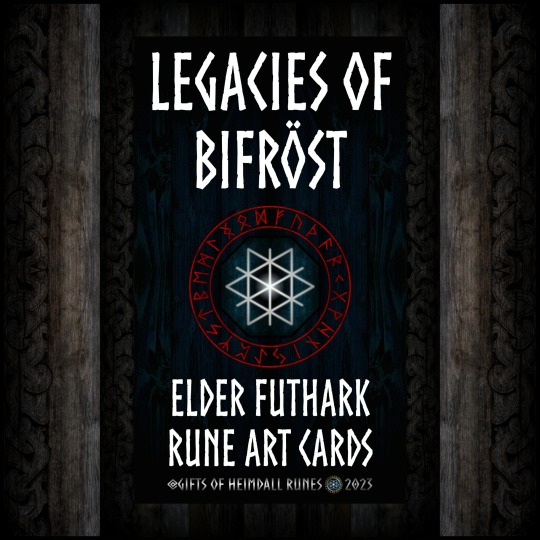
'Legacies of Bifröst - Abstract Staves II' showed a rune art project created by @gifts-of-heimdall-runes. The project was an expression of continued personal interactions with rune energy by creative expressions.
●
There were two parts to this project:
1) Rune Textures
2) Rune Circles & Reflections
RUNE TEXTURES:




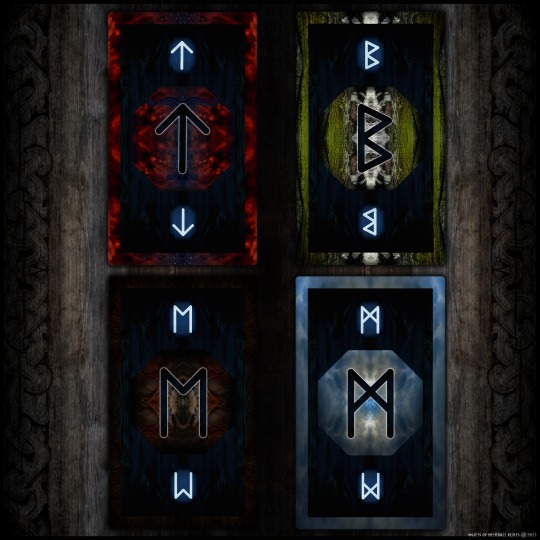
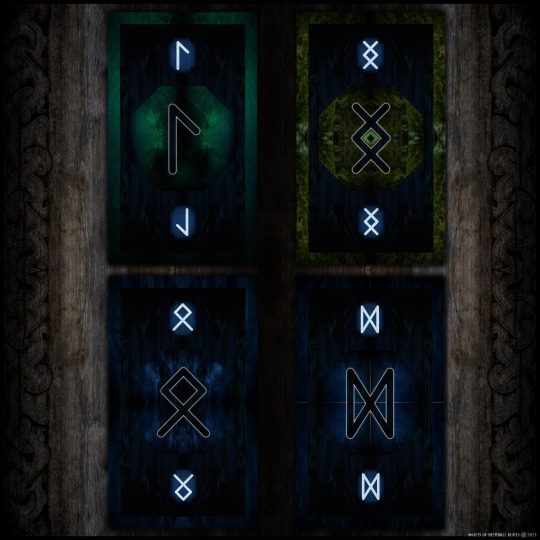
The second part of 'Legacies of Bifröst' showed mounted individual rune circle art cards and rune reflection cards for the twenty-four runes of the Elder Futhark. Correspondences posted with 'Reflections' designs showed condensed rune notes and journeys shared with 'Bifröst Shining' & 'Textures of Bifröst' that began in 1997 and continued to the current day. The text for each rune communicated an understanding of a larger journey of personal and trans-personal initiation throughout the 24 staves of the Elder Futhark.
●
Rune names were deliberately taken from Wardruna music albums 'gap var Ginnunga', 'yggdrasil' & 'Ragnarok' rather than using more popular proto-Germanic. I'm a big fan of Wardruna music!
●
RUNE CIRCLES & REFLECTIONS:



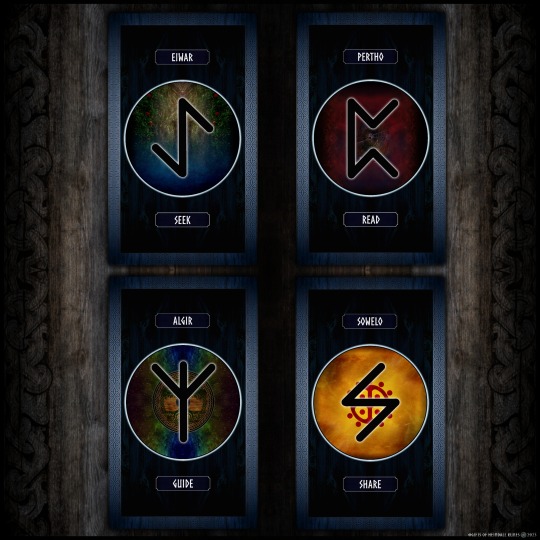
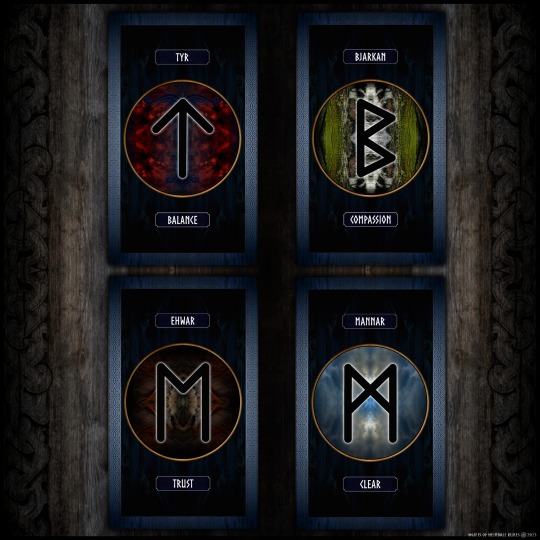

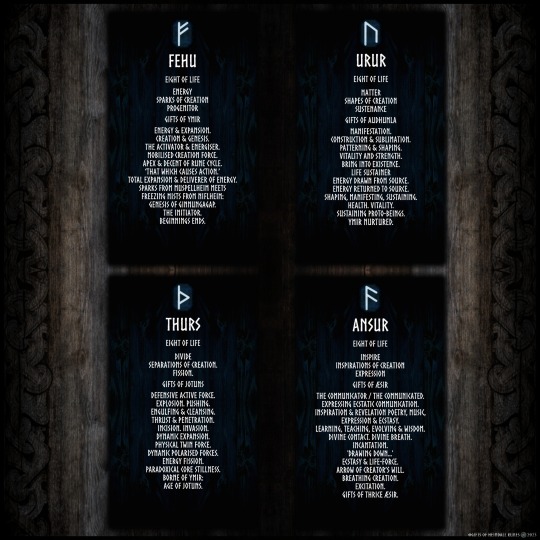





The cards were divided according to the three Ætts (eights) of the Elder Futhark which my inner journeys have associated with:
○ First Eight: Journeys of Creation (as decribed by norse mythology).
○ Second Eight: Journeys Within: Norns and travelling Yggdrasil.
○ Third Eight: Journeys of Soul via the Norse Gods to Ragnarök.

This end design showed a reverse common card design for printed rune art cards. The designs vary slightly to what was shared on Instagram & Facebook due to personal preference changes.
●
The non-commercial deck was printed by Make Playing Cards (MPC) for a personal collection of rune art cards. The photos were take on a rather cloudy day in January 2024!


●
Legacies of Bifröst rune art project and any content therein was created for fun and shared to express celebrating a continued journey with the runes and Spirit inspiration and to perhaps inspire others with their own rune travels. To most of everyone else, these designs represent a load of nonsense created by an eccentric Englishman.
●
'Legacies of Bifröst' was created on & off May -July 2023, then shared Autumn 2023 via Facebook & Instagram. Page wallpaper was created from originals found via Pinterest and @forndom then edited by Mirror Lab app & Serif DrawPlus software.
●
Gifts of Heimdall Runes (FACEBOOK)
Gifts of Heimdall Runes (INSTAGRAM)
#gifts of heimdall runes#gifts of heimdall#gifts of heimdall runes art#gifts of heimdall runes designs#gifts of heimdall rune oracle cards#Rune#Runes#futhark#futhark runes#elder futhark#rune art#elder futhark runes#rune designs#norse runes#elder futhark rune cards#elder futhark rune designs#rune magick#norse paganism#norse heathen#norse pagan#norse gods#personal art#my art#my artwork#Legacies of Bifrost#Legacies of Bifrost rune art#futhark rune art#heimdall gifts runes#bifrost#runic art
5 notes
·
View notes